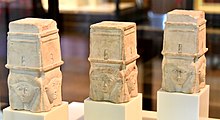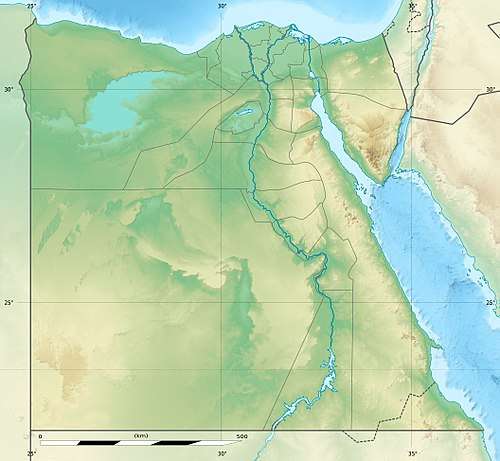Tuna el-Gebel
Tuna el-Gebel (Arabic: تونة الجبل, Coptic: ⲑⲱⲛⲓ[1]) was the necropolis of Khmun (Hermopolis Magna). It is located in Al Minya Governorate in Middle Egypt.

Tuna el-Gebel تونة الجبل | |
|---|---|
 Tuna el-Gebel تونة الجبل Location in Egypt | |
| Coordinates: 27°44′18″N 30°42′16″E | |
| Country | |
| Governorate | Minya Governorate |
| Time zone | UTC+2 (EST) |
Boundary stelae
The oldest monument in the area is one of the Boundary Stelae of Akhenaten, up in the cliffs, protected by a glass 'booth'. This makes it quite difficult to see properly, but prevents further erosion.

Catacombs
Later catacombs were dug under the necropolis; these were used to store thousands of sacred mummies of falcons, baboons and ibises.
Tomb of Petosiris
Near to the modern entrance to the catacombs is the tomb of the 4th century BC high priest Petosiris. This sepulchre is constructed to look like a temple, resembling Dendera. The outside is decorated in typical Late Period style, whereas the outer court is ornamented in a Greek style. The tomb was constructed around the time of the conquest of Egypt by Alexander the Great, and seems to have been decorated like this to curry favour with the new Ptolemaic rulers.
Tomb and chapel of Isadora
Isadora was a wealthy and beautiful young woman living in Hermopolis during the time when the Roman emperor Antoninus Pius (AD 138–161) ruled over Ægyptus. She fell in love with a young soldier from Antinoöpolis (current Sheikh ‘Ibada), and they wanted to get married. However, her father refused, so the young couple decided to elope. Unfortunately, Isadora drowned while crossing the Nile. Her body was mummified, and her father built an elaborate tomb for her, featuring a poem of 10 lines inscribed in Greek elegiac couplets. At some time after her death, a cult developed around her tomb. Isadora's mummified remains are still present, encased in glass, in her mausoleum—a prominent building at Tuna el-Gebel.[2]
Recent discoveries
Egypt’s Minister of Tourism and Antiquities announced the discovery of the collective graves of senior officials and high clergies of the god Djehuty (Thoth) in January, 2020. Archaeological mission headed by Mustafa Waziri reported that 20 sarcophagus and coffins of various shapes and sizes, including five anthropoid sarcophagus made of limestone and carved with hieroglyphic texts, as well as 16 tombs and five well-preserved wooden coffins were unearthed by their team.[3][4]
See also
- List of ancient Egyptian sites, including sites of temples
References
- https://st-takla.org/books/pauline-todary/coptic-language/egyptian.html
- Paul Graindor, "Inscriptions de la nécropole de Touna el-Ghebel (Hermoupolis) [avec 6 planches]," Bulletin de l'Institut Français d'Archéologie Orientale 32 (1932), p. 101
- "In photos: Communal tombs for high priests uncovered Upper Egypt - Ancient Egypt - Heritage". Ahram Online. Retrieved 2020-06-28.
- "Tombs of High Priests Discovered in Upper Egypt - Archaeology Magazine". www.archaeology.org. Retrieved 2020-06-28.
![]()